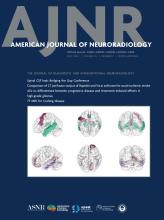I appreciate the work of Okromelidze et al1 on the “Central Vein Sign in Multiple Sclerosis: A Comparison Study of the Diagnostic Performance of 3T versus 7T MRI.” Their study uses the largest 7T MR imaging cohort, demonstrated excellent MS differentiation with 3T SWI, 7T SWI, and 7T T2*WI. Optimal thresholds of 40%, 15%, and 12% for 7T T2*WI, 7T SWI, and 3T SWI, respectively, yielded 100% accuracy, sensitivity, and specificity, with areas under the curve of 1.0 at 7T and 96.0% accuracy, 93.4% sensitivity, and 100% specificity at 3T. However, several factors may have influenced the reported performance metrics.
The authors included lesions without size limitations. They justified including smaller lesions by stating that histopathologically small lesions also have central veins. However, the North American Imaging in MS Cooperative2 (https://www.naimscooperative.org/) recommends the exclusion of lesions of <3 mm. Considering that the control group mostly comprises lesions of presumed vascular origin and typical MS lesions are >3 mm, lesion size is a potential confounder here. Moreover, they reported that the total number of lesions in the control group is higher (1088 control versus 903 for MS), even though the number of patients is notably lower (39 control versus 61 for MS). This discrepancy could be due to the inclusion of small lesions of vascular origin, in which the evaluation of the central vein sign (CVS) is difficult. Also, larger lesions are more likely to incidentally harbor veins. Reporting the median average lesion diameter for each group would help clarify this issue I suspect it is significantly smaller in the control group in this case.
Another potential confounder is location. In the MS group, a significant number (340/930) of lesions were located in the periventricular area, as expected. In the control group, most lesions were in the subcortical area (675/1088). Periventricular lesions display the highest prevalence of central veins, and this could be elucidated by increased concentration of parenchymal veins in periventricular regions, particularly at 7T,2 increasing risk of false positivity. As lesions progress toward the periphery, the proportion of cases positive for the CVS decreases, owing to reduced vein size, making detection more challenging. Even though the percentage of CVS presence is higher in MS when each location is evaluated separately, in Table 3, this could still be influenced by the average lesion diameter.
Additionally, Table 2 displays discrepancies in total lesion numbers between groups. I believe that the control and MS summations are erroneously swapped.
As the use of 7T increases, the CVS is also gaining popularity. It is imperative to determine whether the observed findings stem from the CVS itself or are influenced by a lack of standardization. Making adjustments for potential confounders is crucial to ensure precise threshold determination and enhance diagnostic utility.
Footnotes
Disclosure forms provided by the authors are available with the full text and PDF of this article at www.ajnr.org.
References
- © 2024 by American Journal of Neuroradiology












